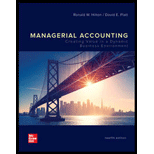
Managerial Accounting: Creating Value in a Dynamic Business Environment
12th Edition
ISBN: 9781260417074
Author: HILTON, Ronald
Publisher: MCGRAW-HILL HIGHER EDUCATION
expand_more
expand_more
format_list_bulleted
Textbook Question
Chapter II, Problem 8E
Refer to the answers given for the preceding exercise.
Required:
- 1. Refer to requirement (1) of the preceding exercise. Prepare a display similar to Exhibit II-1 to show how your accumulation grows each year to equal $5,487.50 after six years.
- 2. Refer to requirement (4) of the preceding exercise. Prepare a display similar to Exhibit II-3 to verify that $32,331 is the amount you need to fund your educational expenses.
Expert Solution & Answer
Want to see the full answer?
Check out a sample textbook solution
Students have asked these similar questions
Please provide the accurate answer to this general accounting problem using valid techniques.
Given the following information how much raw material was transferred to work in progress on March 31? Inventory on March 1 is $420,000, raw materials purchased in March are $735,000, and raw materials inventory on March 31 is $185,000. A: $890,000 B: $970,000 C: $780,000 D: $955,000
I am trying to find the accurate solution to this general accounting problem with the correct explanation.
Chapter II Solutions
Managerial Accounting: Creating Value in a Dynamic Business Environment
Knowledge Booster
Learn more about
Need a deep-dive on the concept behind this application? Look no further. Learn more about this topic, accounting and related others by exploring similar questions and additional content below.Similar questions
- General accountingarrow_forwardI need assistance with this financial accounting problem using valid financial procedures.arrow_forwardWhich of the following is a characteristic of a perpetual inventory system? a. Inventory records are updated continuously b. Cost of goods sold is calculated at the end of the period c. Inventory is only counted at year-end d. Physical counts are never required MCQarrow_forward
- At the beginning of the recent period there were 1,250 units of product in a department, one-half completed. These units were finished and an additional 6,300 units were started and completed during the period. 820 units were still in process at the end of the period, one-third completed. Using the weighted-average valuation method, the equivalent units produced by the department were ___ units.arrow_forwardANSWERarrow_forwardAccurate answerarrow_forward
- Can you help me solve this general accounting problem using the correct accounting process?arrow_forwardSullivan Manufacturing estimates that overhead costs for the next year will be $3,200,000 for indirect labor and $480,000 for factory utilities. The company uses machine hours as its overhead allocation base. If 160,000 machine hours are planned for the next year, what is the company's plantwide overhead rate? HELParrow_forwardDuring 2019, Driscoll Company earned revenues of $175,000, had expenses of $128,000, purchased assets with a cost of $22,000, and paid dividends of $12,500. What was the net income for the year?arrow_forward
arrow_back_ios
SEE MORE QUESTIONS
arrow_forward_ios
Recommended textbooks for you
 Intermediate Accounting: Reporting And AnalysisAccountingISBN:9781337788281Author:James M. Wahlen, Jefferson P. Jones, Donald PagachPublisher:Cengage Learning
Intermediate Accounting: Reporting And AnalysisAccountingISBN:9781337788281Author:James M. Wahlen, Jefferson P. Jones, Donald PagachPublisher:Cengage Learning


Intermediate Accounting: Reporting And Analysis
Accounting
ISBN:9781337788281
Author:James M. Wahlen, Jefferson P. Jones, Donald Pagach
Publisher:Cengage Learning

5 Steps to Setting Achievable Financial Goals | Brian Tracy; Author: Brian Tracy;https://www.youtube.com/watch?v=aXDuLxEJqBo;License: Standard Youtube License